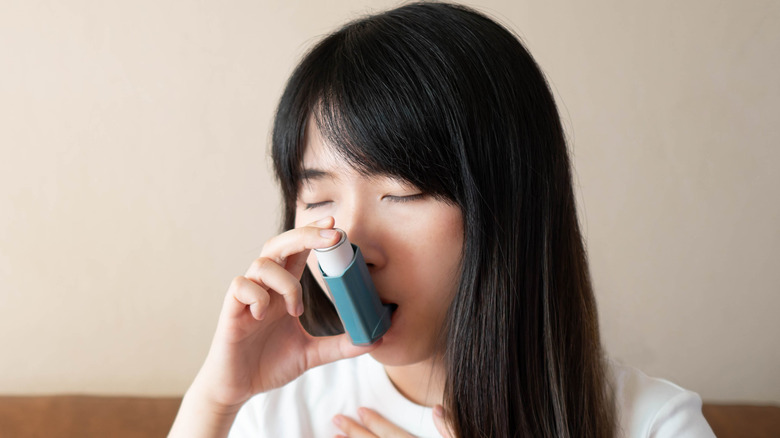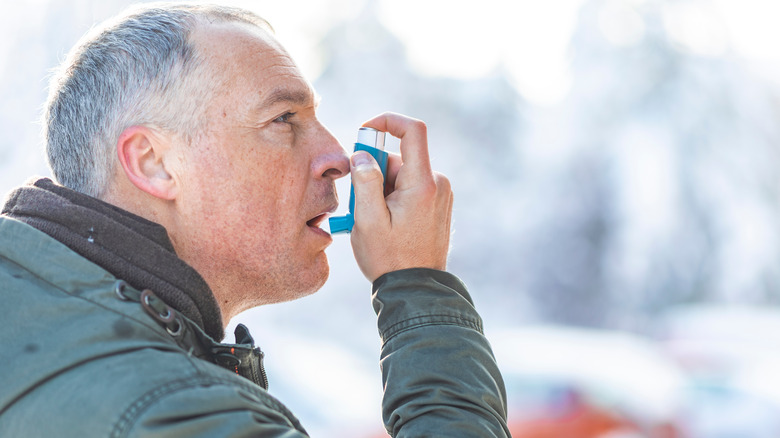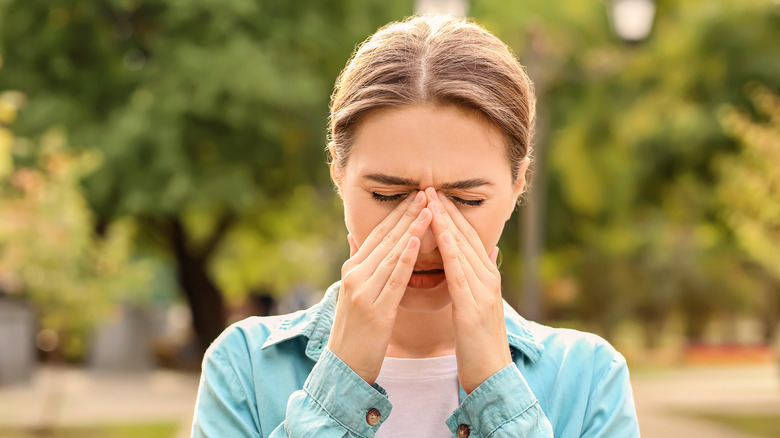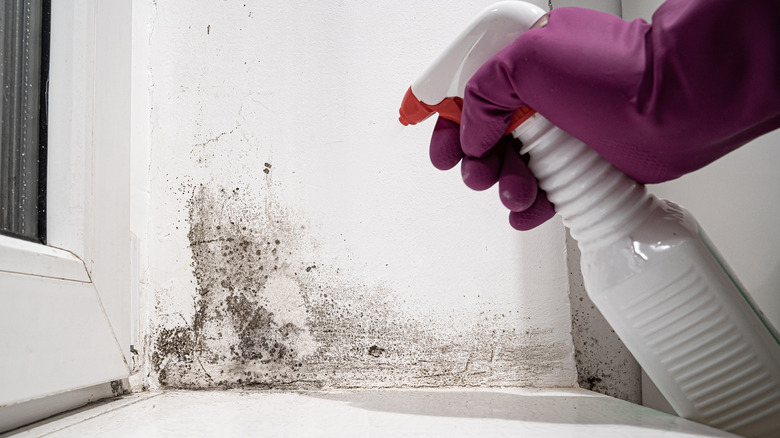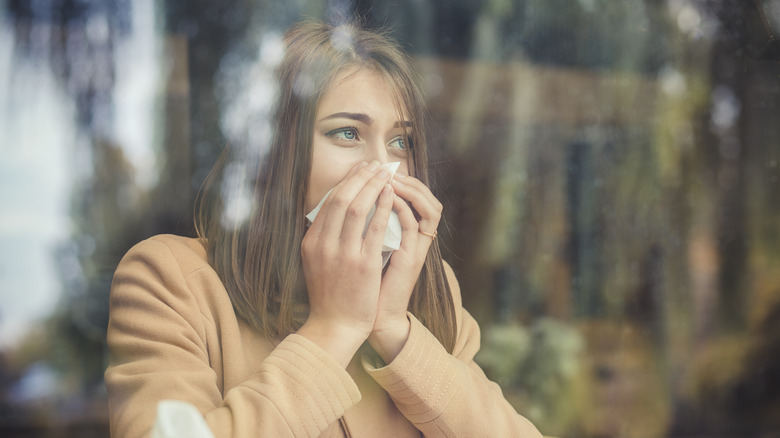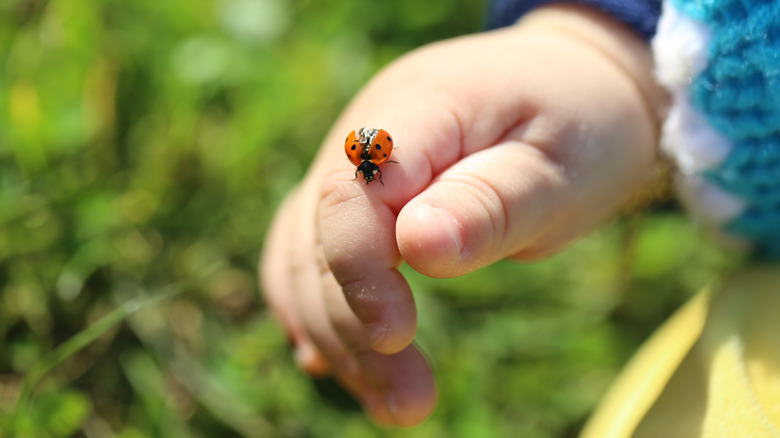Things That Could Be Making Your Asthma Worse
Being caught off-guard by an asthma attack can be pretty scary — the sudden shortness of breath, the band of tightness around the chest, the feelings of panic and anxiety. For some asthma sufferers, these symptoms may strike at any moment, which is why identifying and reducing exposure to the specific factors that affect you can help prevent a potential crisis (via WebMD).
Asthma is a chronic disorder characterized by the narrowing and obstruction of the airways to the lungs (known as the bronchial tubes) due to inflammation (via Medical News Today). Reference to breathlessness was recorded as early as 2,600 BCE in China, but the term "asthma" was first used by Hippocrates (460 BCE) to describe panting and respiratory distress (via Asthma.net). Despite being around for more than two and a half millennia, nearly 25 million people in the United States are plagued by this incurable respiratory condition, according to the Allergy and Asthma Medical Group and Research Center.
The treatment of asthma has a long history of evolution, from owl's blood and wine to inhaled corticosteroids (via News Medical). We have come a long way in our understanding of what underlies the illness, and there have been many therapeutic advances. Here are some triggers — predictable and peculiar — that could be making your asthma worse and exacerbating your symptoms.
Cold wintry air
People with asthma are generally very sensitive to their environment. Some may notice their symptoms heighten during the winter and that breathing feels like more of a chore when they go outside (via Cleveland Clinic). A dip in temperature can certainly add to your asthma woes.
"Cold air irritates the airways," pediatrician Roopa Thakur explained to Cleveland Clinic. Inhaling the icy winter air can cause the airways to swell and become narrower and the muscles around them to spasm, accelerating symptoms like wheezing and coughing. Cold air can also cause the airways to become lined with thick, sticky mucus, making it harder for oxygen to pass through (via WebMD).
In winter, the air holds less moisture than warm air, which can spark a number of respiratory problems including asthma, sinusitis, and bronchitis (via Cleveland Clinic). People also tend to spend more time indoors during the winter, where the air is drier and they're exposed to various other asthma-triggers like mold, dust mites, and pet dander. "The winter season also brings more exposure to cold and flu viruses," Dr. Thakur told Cleveland Clinic. "A lot of kids have viral-induced asthma, which means they can experience an asthma attack as a result of a respiratory infection."
Strong emotions
It may not be as well-known as other triggers, but emotions can induce asthma in some people. There's evidence of a link between emotional states like anxiety and depression and poor asthma control, according to the Asthma and Allergy Foundation of America. A theory behind this is that our emotions affect the way we breathe, in turn, setting off asthma symptoms.
The American College of Allergy, Asthma & Immunology also cites physical displays of strong emotion like shouting, crying, or laughing as potential triggers as a result of changing breathing patterns. For example, scientists have found that strong emotions can cause our breathing rate to speed up and bronchial tubes to tighten, potentially eliciting asthma symptoms or precipitating an asthma attack.
Stress is notorious for underlying a wide array of physical and mental health problems. So, it's not surprising that it can also worsen your asthma. Research published by Brain, Behavior, and Immunity has shown that the body reacts to stress by triggering the immune system and releasing certain hormones, which can alter the airway inflammatory response to irritants, allergens, and infections in people with asthma.
Exercise
Exercise is one of those asthma triggers that can throw you off course. Research published in Scientific Reports continues to show that regular and moderate exercise is beneficial for asthmatics and helps improve asthma control. But for some people, hitting the gym and working out can spark a number of asthmatic symptoms like wheezing, coughing, and shortness of breath, according to the Asthma and Allergy Foundation of America.
As many as 90% of individuals struggling with asthma will experience exercise-induced asthma (also referred to as exercise-induced bronchoconstriction) during or after strenuous exercise. This occurs when you breathe more rapidly and deeply due to your body needing more oxygen. When you breathe through your mouth, the air you inhale tends to be drier and colder than the air that comes in through your nose, which brings about a narrowing of the airways (also known as bronchoconstriction). Exercising outdoors during winter is particularly triggering for people with asthma, whose airways are generally sensitive to chilly temperatures (via Asthma UK).
"Cold air is a trigger for more than 3 million people with asthma, putting them at risk of a potentially life-threatening asthma attack," explains Emma Rubach, head of health advice at Asthma UK. If you notice that exercise often leads to asthma flare-ups, your doctor may prescribe a pre-exercise medication to open your airways, such as an inhaler that releases a short-acting beta agonist, the Mayo Clinic notes.
Pollen
Spring can be an especially hard time for people who are allergic to wind-borne pollen from trees, grasses, and weeds (via National Asthma Council Australia). And, it's very common for those struggling with allergies like hay fever to also have asthma.
Pollen triggers an allergic reaction when your immune system produces antibodies upon identifying a harmless environmental irritant, like tree pollen, as an invader (via Healthline). The antibodies bind to the allergen as a way to protect your body from this substance, while the chemicals that are released during this process, like histamine, induce an uptick in allergy symptoms: an itchy, runny, or congested nose, itchy eyes, and skin reactions. For some, pollen can also elicit the onset of an asthma attack by causing inflamed airways to produce more mucus than usual, per Healthline.
Around 60-90% of people with asthma struggle with allergic asthma, also known as "extrinsic asthma" (via Medical News Today). This is when asthma symptoms and episodes are specifically caused by an allergen such as pollen. Antihistamines can help ward off symptoms, but it's important to note that some corticosteroid nasal sprays, like fluticasone, which are used to treat hay fever or allergic rhinitis, can sometimes worsen asthma symptoms like wheezing or shortness of breath (via Healthline). Ask your doctor about other medications you might be able to take instead to avoid a potentially dangerous asthma attack.
Traffic jams
Being stuck in a traffic jam might be a lesser-known trigger for your asthma attack (via Asthma UK). It's not so much the traffic jam itself that's setting off your asthma symptoms, but rather the pollution and fumes released into the atmosphere, which can get into your lungs and irritate your airways. Research evidence in the International Journal of Health Geographics highlights the link between air pollution from road traffic and asthma, explaining that pollutant exposure may increase the permeability of the airways to other allergens to which asthmatics are susceptible.
What's more, driving with the windows down might feel amazing, but it will let in all of the toxic emissions spewing out of the surrounding cars, reports Healthline. "People who regularly drive with the windows down may find their asthma is harder to control at different times of year," Ryan Thomas, a pulmonologist and director of the Michigan State University Pediatric Pulmonary CMDS Clinics, told the publication.
Cleaning products
A good old spring clean can do wonders to help clear up your asthma (via MedicineNet). In fact, the American Academy of Allergy Asthma & Immunology (AAAAI) recommends cleaning your home at least once a week to reduce the amount of allergens in the atmosphere. But it may surprise you to discover that your cleaning products might also be at the root of your asthma attacks. Some household cleaners contain harsh chemicals, like bleach and ammonia, that are likely to aggravate your airways and make your asthma worse, the AAAAI also reported, which is why it's important for people with asthma to be mindful of the types of products that they use to avoid creating a toxic and triggering environment in their house.
If you're opting for commercialized cleaning products, the AAAAI recommends keeping an eye out for those that have been given a "Green Seal" of approval. They tend to be gentler on the environment and your respiratory system as many of them come from natural or plant sources. You can also concoct a non-toxic cleaning solution of your own if you're feeling nifty, using vinegar, lemon, and baking soda in a spray bottle.
Mold
Mold is one of the many potential allergens that can accumulate in your home. This microscopic organism is a common type of fungus that thrives in environments with lots of moisture (via American Lung Association). It reproduces by means of tiny spores that float through the atmosphere and settle on surfaces like the ceiling, walls, and your belongings, causing respiratory problems when inhaled by people with asthma or mold allergies, warns the United States Environmental Protection Agency.
Mold spores can irritate your nasal passageways and cause allergies; it can also creep into your lungs and lead to asthma flare-ups (via Asthma and Allergy Foundation of America). Some individuals might have trouble catching their breath in moldy environments due to reduced lung function, per American Lung Association. Mold can cause the airways to constrict and produce more mucus, becoming swollen and inflamed. Some people with asthma have even been known to die due to a mold-induced allergic reaction, so it's important that you limit your exposure to fungi where possible if you find yourself experiencing immediate or delayed symptoms.
More rarely, people can have a more severe condition called allergic bronchopulmonary aspergillosis, which involves both an allergic and an inflammatory reaction to mold, reported by Asthma and Allergy Foundation of America. Just like asthma, symptoms include coughing, wheezing, and sudden shortness of breath.
Menstruation
Research indicates that the prevalence of asthma is around 9.7% in women and 5.5% in men. If, like some women, you've noticed that your asthma tends to get worse around menstruation, you're probably not imagining things. Many women have a tougher time breathing during their premenstrual period. This commonly-occurring phenomenon is referred to as premenstrual asthma (PMA), a condition in which asthma symptoms and lung function start to deteriorate a few days before menstruation begins (via Everyday Health).
"About half of women with asthma report a worsening of asthma symptoms right before or during their period," William E. Berger, a clinical professor of allergy and immunology at the University of California, told Everyday Health.
Premenstrual asthma is attributed to fluctuating hormones. Just before and during your period, your body's progesterone and estrogen levels drop, which can cause the airways to constrict and the cells of the immune system to weaken. What's more, the lungs' blood vessels are said to form and disappear as hormones change, which can increase or decrease their ability to take in oxygen, causing symptoms to see-saw.
Cured meat
The role our diet plays in provoking asthma flare-ups is occasionally overlooked. But, research published in the journal Nutrients confirms that certain foods have pro- or anti-inflammatory effects, in that they can either improve or worsen symptoms. A traditional Western diet is said to be particularly triggering (via Everyday Health).
Processed foods that contain preservatives and artificial colorings have been identified as some of the main culprits to increase asthma symptoms by worsening lung function and inflammation, according to a 2014 study in Pediatric Allergy and Immunology. The Physicians Committee for Responsible Medicine specifically points towards the regular consumption of processed meat as a contributing factor to asthma symptoms. A 2017 study published in the journal Thorax also lends support to this idea: researchers found that people who ate cured meat up to four or more times per week over seven years reported unstable or deteriorating asthma symptoms. The reasons behind this require further research, though, another 2016 study in the same publication has attributed it to the presence of nitrates in meat products.
"The clinical evidence for dietary changes as a primary treatment for asthma is still evolving, but there's plenty of evidence that suggests a healthy diet is beneficial," Meredith C. McCormack, a medical director and associate professor of medicine at Johns Hopkins Medicine, told Everyday Health.
Alcohol
It's one of those inconvenient triggers that not everyone wants to concede to, but alcohol might be one of the unexpected things exacerbating your asthma. This has been corroborated by a research study published in The Journal of Allergy and Clinical Immunology, which showed that 33% of study participants identified a link between alcohol and an asthmatic event on two separate occasions, with wine being pinpointed as the main inducer.
A specific offender is said to be those sulfites, which are commonly added to wine and beer as preservatives, and sometimes appear to have a negative effect on people struggling with moderate to severe symptoms, says the American College of Allergy, Asthma & Immunology. Somewhere between 1% and 2.5% of people with asthma also have a sulfite sensitivity (via Cleveland Clinic).
Another sneaky ingredient that can be found in your favorite alcoholic beverage is histamine — a natural food and drink chemical, and a substance that your body releases when you have an allergic reaction (via Asthma UK). Histamine is developed from bacteria and yeast when alcohol, particularly red wine, ferments, explains Healthline. It can cause a host of problems for those who suffer from asthma or allergies. Hence, it's recommended that people with inflammation-related chronic conditions like asthma and related breathing problems limit or reduce their intake, or simply avoid alcohol altogether.
Scented candles
While indoor candles and air fresheners may perk up the smell of your home or personal space, they can also cause a host of respiratory problems like asthma, reports the American College of Allergy, Asthma & Immunology. Perhaps you've noticed your symptoms worsening around these airborne irritants?
These perfumed products and odorants emit chemicals, smoke, or fragrances that may aggravate existing allergies and provoke the sensitive airways of people with asthma to contract, details a 2016 study published in the International Journal of Environmental Health Research.
The problem is that these candles don't produce enough heat to destroy the harmful molecules that they release, and are often burnt in unventilated spaces, which elevates the risk of an asthma attack, pulmonologist Katina Nicolacakis informed Cleveland Clinic. "There are many patients for whom anything scented –- candles, pine cones, right down to their live Christmas tree –- will spark an asthma attack," Nicolacakis says. "These are people who just can't have scented things in their homes." In which case, replacing your scented candles with natural, unscented ones may help tame your asthma.
Thunderstorms
This one might sound odd, but a thunderstorm can set off an asthmatic episode, based on research. The findings of a 2016 study in the journal Clinical and Experimental Allergy revealed that severe asthma epidemics increased dramatically after thunderstorms over pollen season, occurring across various geographical locations. An explanation for this phenomenon is that big storms cause pollen to rupture and explode into microscopic particles that disperse into the atmosphere, resulting in higher levels of airborne pollen exposure, say researchers. People suffering from pollen allergies and asthma are then able to inhale a higher concentration of this allergen.
"Thunderstorm asthma" is most common with grass pollen, though it can also occur with weed pollens and molds (via American Academy of Allergy, Asthma, and Immunology). Grass pollen is typically filtered through the nasal passageways before reaching the respiratory tracts, but when it's broken down into smaller fragments during a storm, it can subsequently enter into the lungs, resulting in an asthmatic response.
Aspirin
While popping an aspirin might help relieve a throbbing headache, it can also give rise to an array of asthma symptoms (via WebMD). The role of aspirin in asthma onset is rarely discussed; unlike a lot of other contributing factors, this trigger remains fairly under the radar.
Asthmatics tend to be sensitive to certain drugs, with approximately 10% to 20% exhibiting a particular intolerance towards aspirin, per WebMD. Aspirin-induced asthma is a potentially life-threatening response to painkillers that can lead to typical asthma symptoms like breath difficulties, coughing, congestion, and wheezing. These symptoms tend to emerge within 30 minutes to two hours of taking a painkiller like aspirin or nonsteroidal anti-inflammatory drugs (NSAIDs), but can last for hours (via Verywell Health).
The causes behind aspirin-induced asthma remain unclear, per Verywell Health. One theory is that aspirin and NSAIDs block an enzyme called COX-1 (cyclooxygenase-1). This might lead to an overproduction of inflammatory compounds called leukotrienes, which can inflame the airways and cause breathing difficulties.
Swimming in a chlorinated pool
Swimming can help build up lung capacity and reduce inflammation, which are associated with better overall lung health (via Healthline). But, as it turns out, the type of pool you swim in makes a massive difference.
For many years, it's been suggested that spending a significant amount of time in a chlorinated pool can bring on asthma symptoms and drive up your risk of developing a respiratory condition (via MedicineNet). A 2008 study in the European Respiratory Journal identified chlorine as an airway irritant, claiming that the chlorine-laden atmosphere of both indoor and outdoor swimming pools may be detrimental to the lungs by increasing bronchial hyperreactivity and airway inflammation.
It's important to point out, however, that a later 2011 study in the American Journal of Respiratory and Critical Care Medicine challenged the idea that chlorine is responsible for raising the risk of asthma, concluding that more research is needed to investigate this finding. Still, the researchers note that the study cannot disregard the health risks of excessive exposure to chlorine caused by over-chlorination of pools or to acute chlorine inhalation due to swimming pool accidents.
Ladybugs
Ladybugs are a slightly more peculiar culprit to blame for your asthma. Who would've thought that these adorable little insects could act as potent allergens for some individuals? But a 2006 study in the journal Annals of Allergy, Asthma & Immunology revealed that allergy and asthma symptoms increased significantly when people had direct contact with ladybugs, specifically a species called Harmonia axyridis. A correlation was found between the worsening of symptoms among participants and seasonal ladybug infestation, leading the authors to conclude that ladybugs may be a significant cause of respiratory conditions in heavily-infested homes.
According to some experts, the allergic reaction stems from the decomposing body parts of the ladybugs as they wither away inside your house. "That allergen, the dust from their body parts, is pretty strong," Timothy Craig, a fellow of the American Academy of Allergy, Asthma, and Immunology, told HuffPost, adding that sufferers should aim to get rid of the remnants of deceased ladybugs around their home to reduce their asthma and allergy symptoms. Like most triggers, however, the connection between ladybugs and asthma is complex and varies from person to person, requiring further research for a better understanding.

